Sulfur Isotope Ratios from VMS Deposits in the Penokean Volcanic Belt, Great Lakes Region, USA: Constraints on the Source of Sulfur in a Paleoproterozoic Intra-Arc Rift
Abstract
1. Introduction
1.1. Geological Setting
1.2. Previous Work
2. Methods
3. Results
4. Discussion
4.1. Sulfur Isotope Signatures in VMS Deposits
4.2. Distribution of δ34S Ratios in the PVB
4.3. Possible Sources of Sulfur in the PVB
4.4. Implications on Seawater Chemistry
5. Conclusions
- δ34S values of sulfide minerals in the mineralized zones in VMS deposits at the Paleoproterozoic Penokean Volcanic Belt are characterized by consistently narrow ranges around 0‰. The δ34S values have no relationship with the nature of host rocks, types of sulfide minerals, and textural characteristics.
- The clustering of values around 0‰ indicates the origin of sulfur predominantly from a magmatic source. Since VMS deposits are precipitated on the seafloor, the contribution of sulfur from seawater sulfate deserves special importance.
- δ34S values of seawater sulfate in the Paleoproterozoic are poorly constrained, but δ34S values close to the magmatic range have been proposed. Thus, there might have been a limited supply of sulfur from seawater sulfate at shallow water levels, but the δ34S value of sulfur from this source must have been close to the magmatic range.
- The geographic distribution of δ34S in the PVB shows an increasing trend towards the direction of the continental margin in the north. This might indicate a modest degree of derivation of sulfur from oxidized shallow water levels near the continental margin.
Author Contributions
Funding
Acknowledgments
Conflicts of Interest
Appendix A
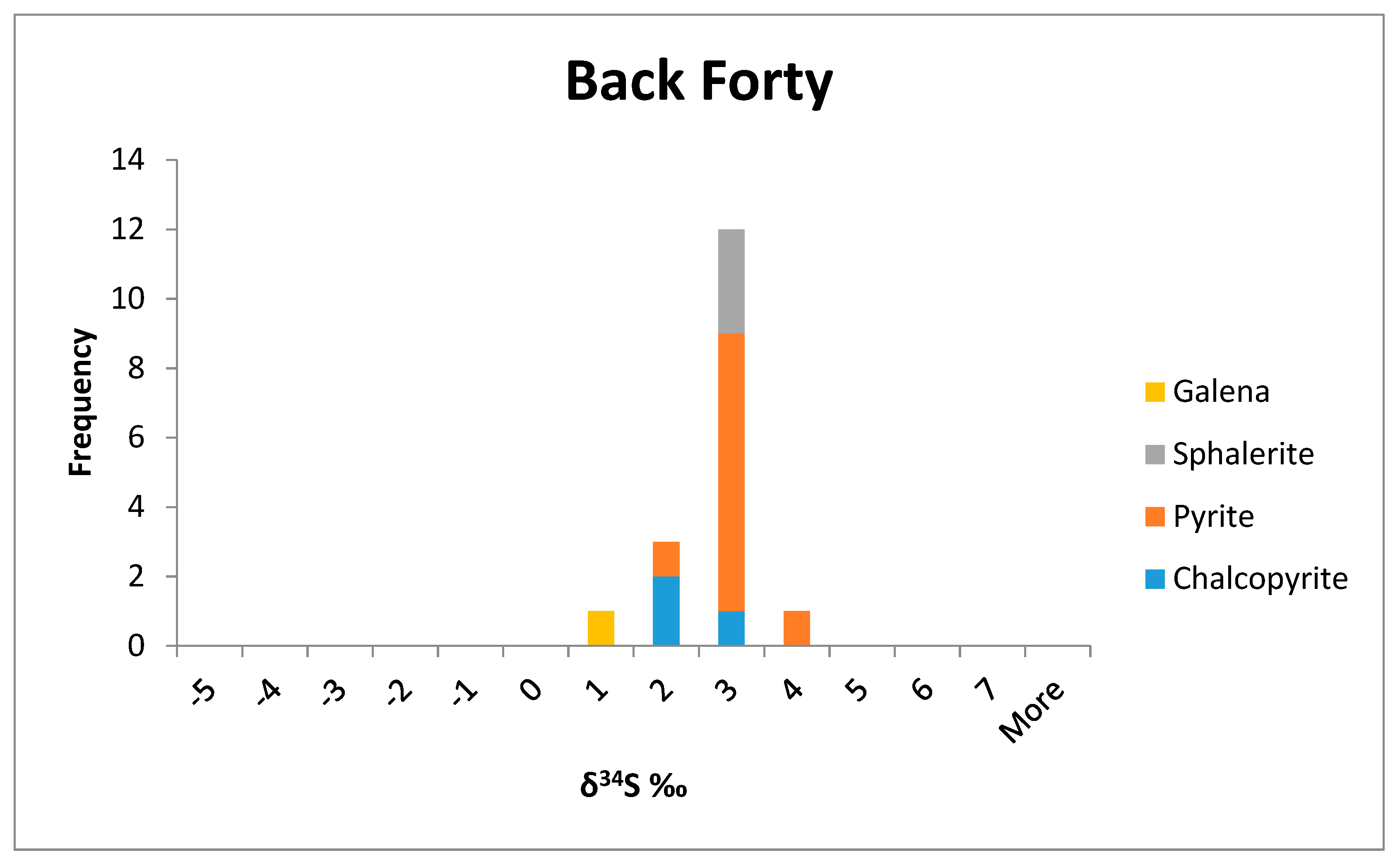
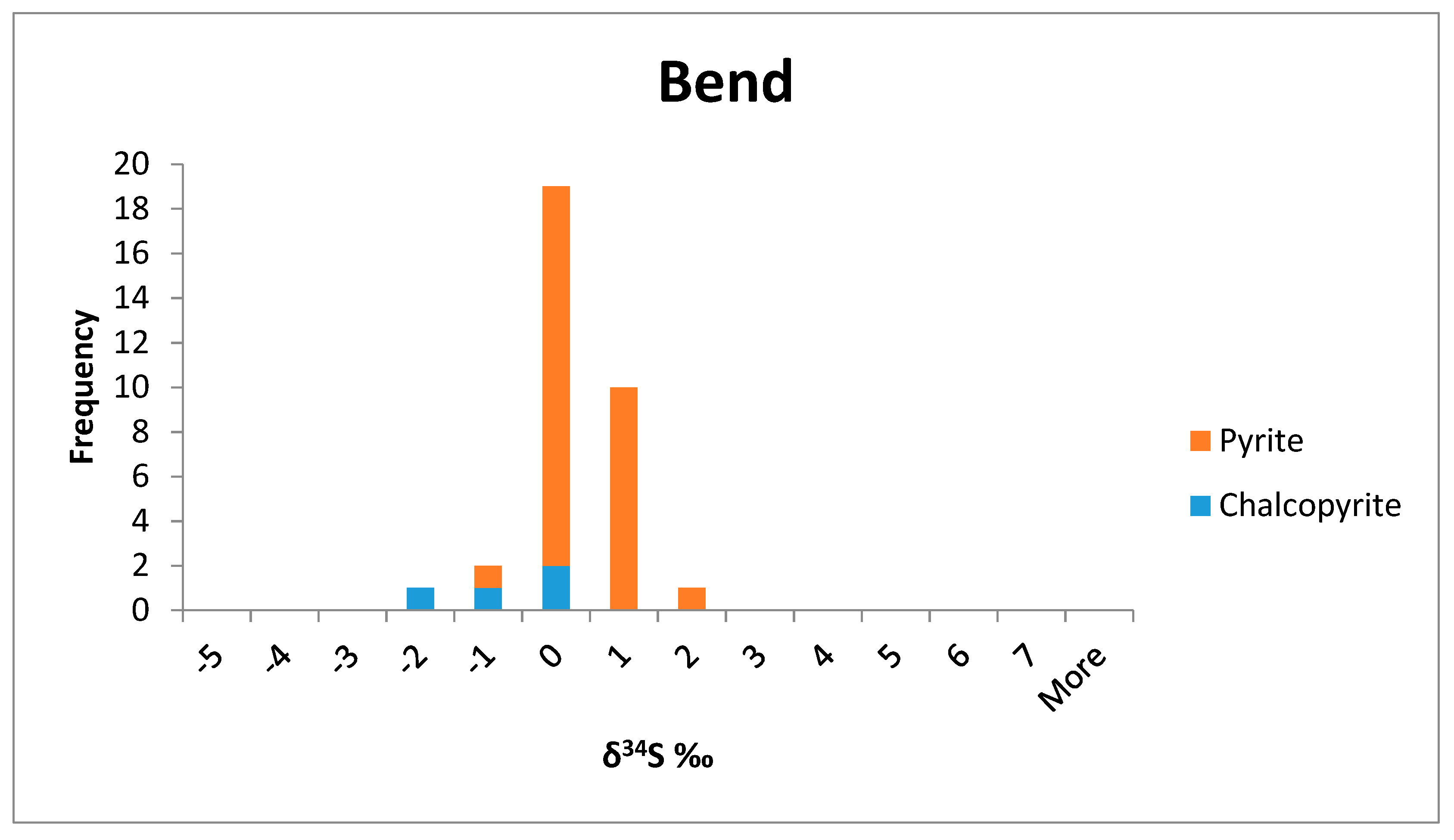
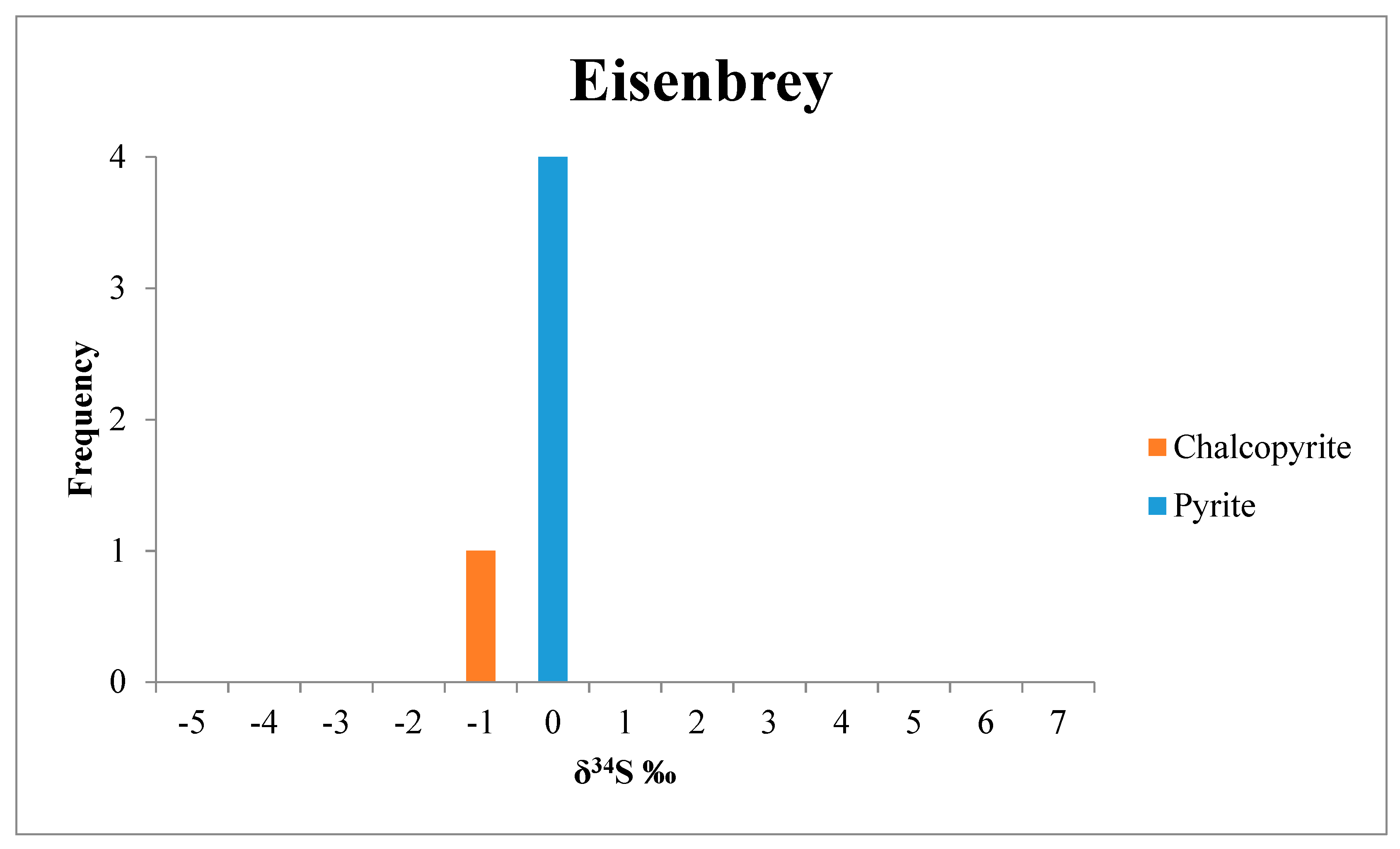
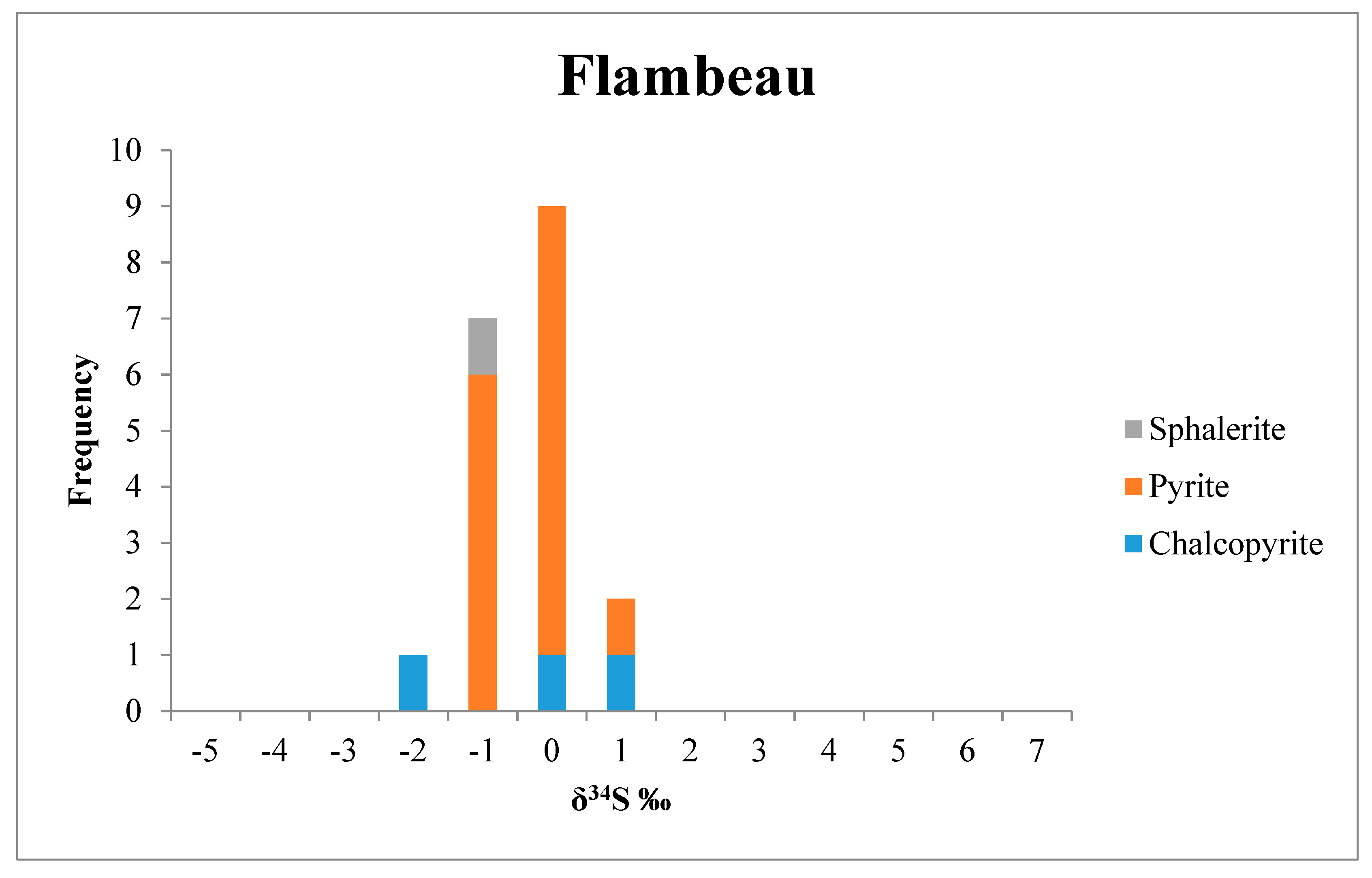
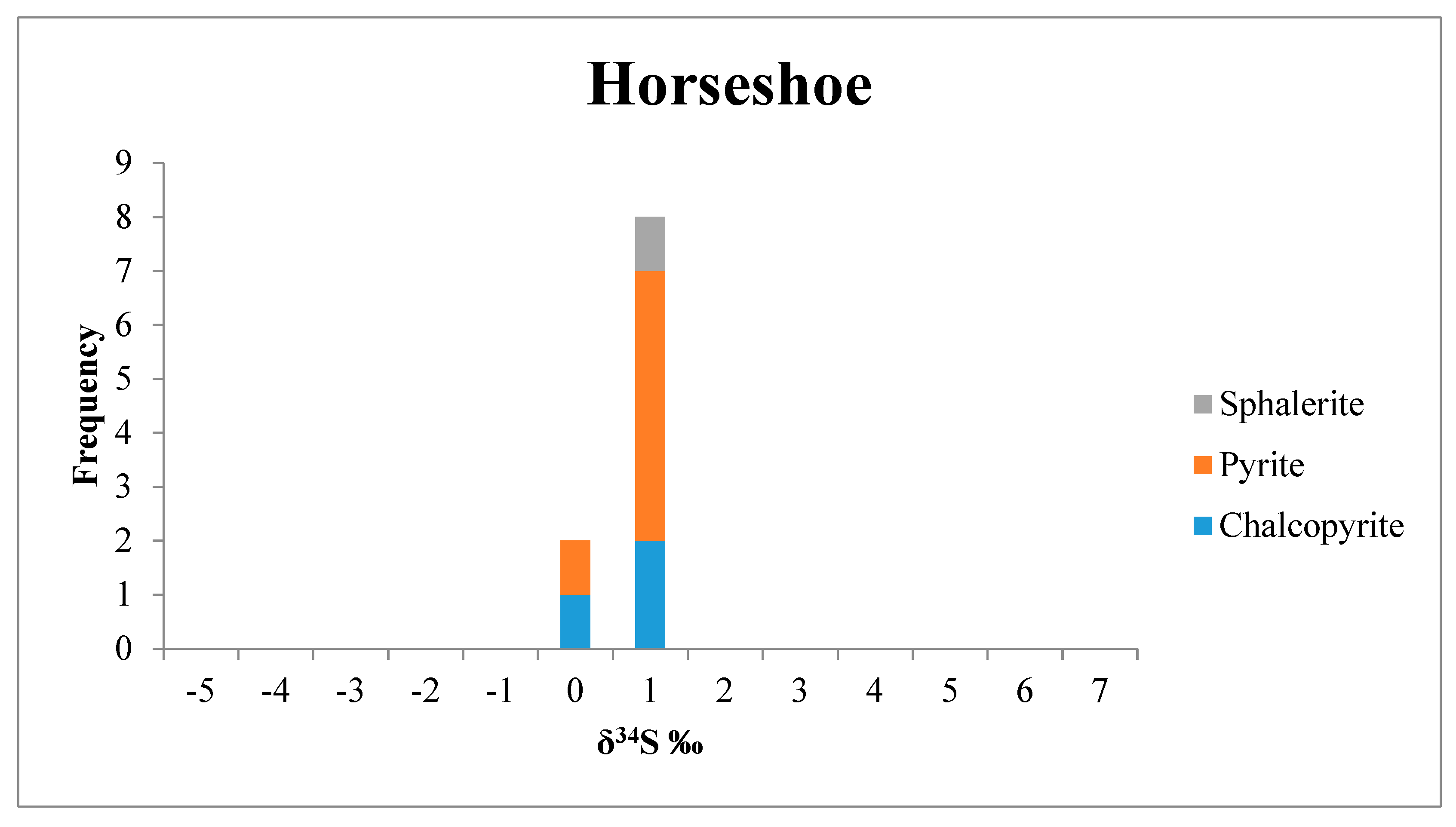
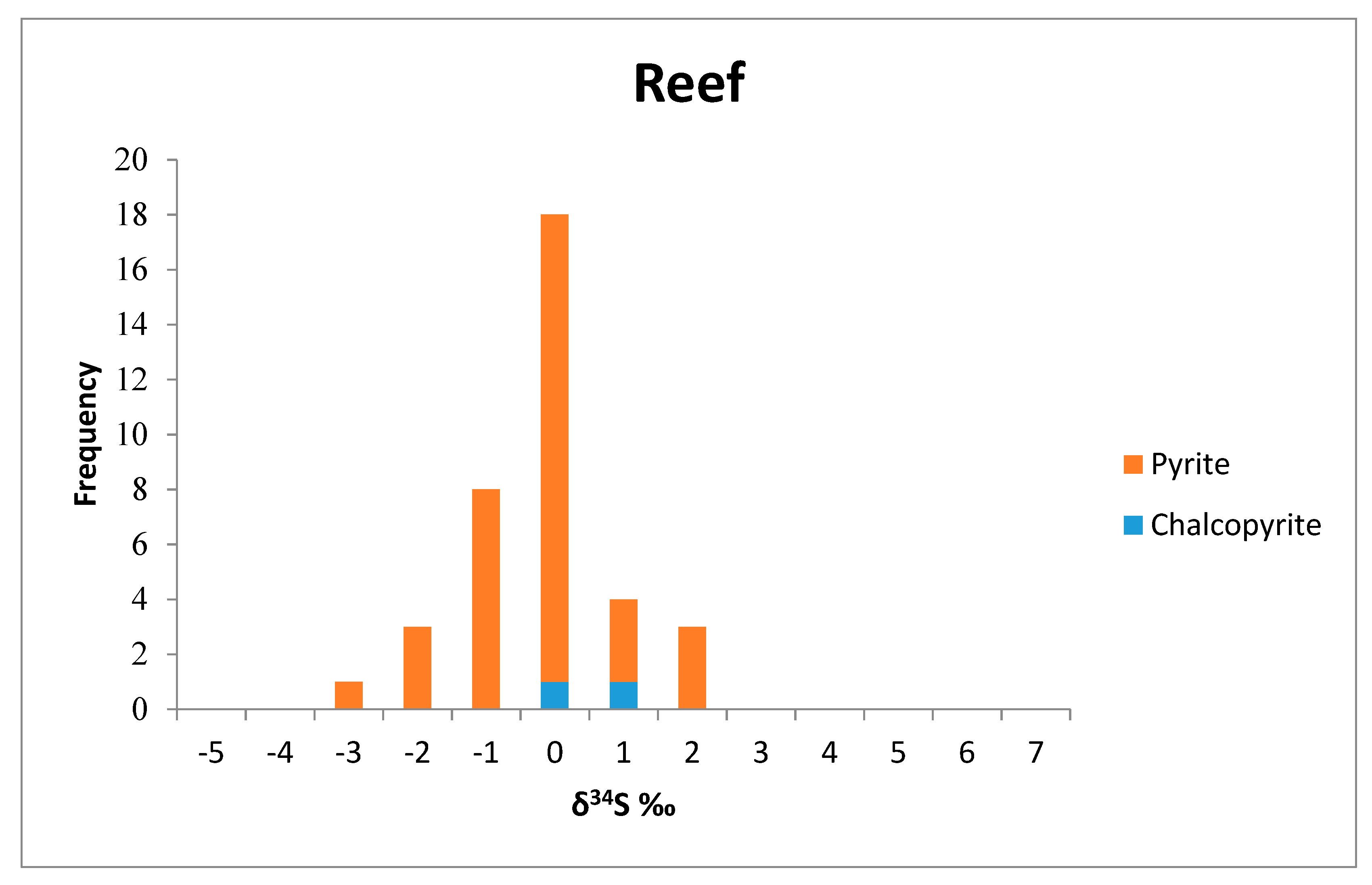
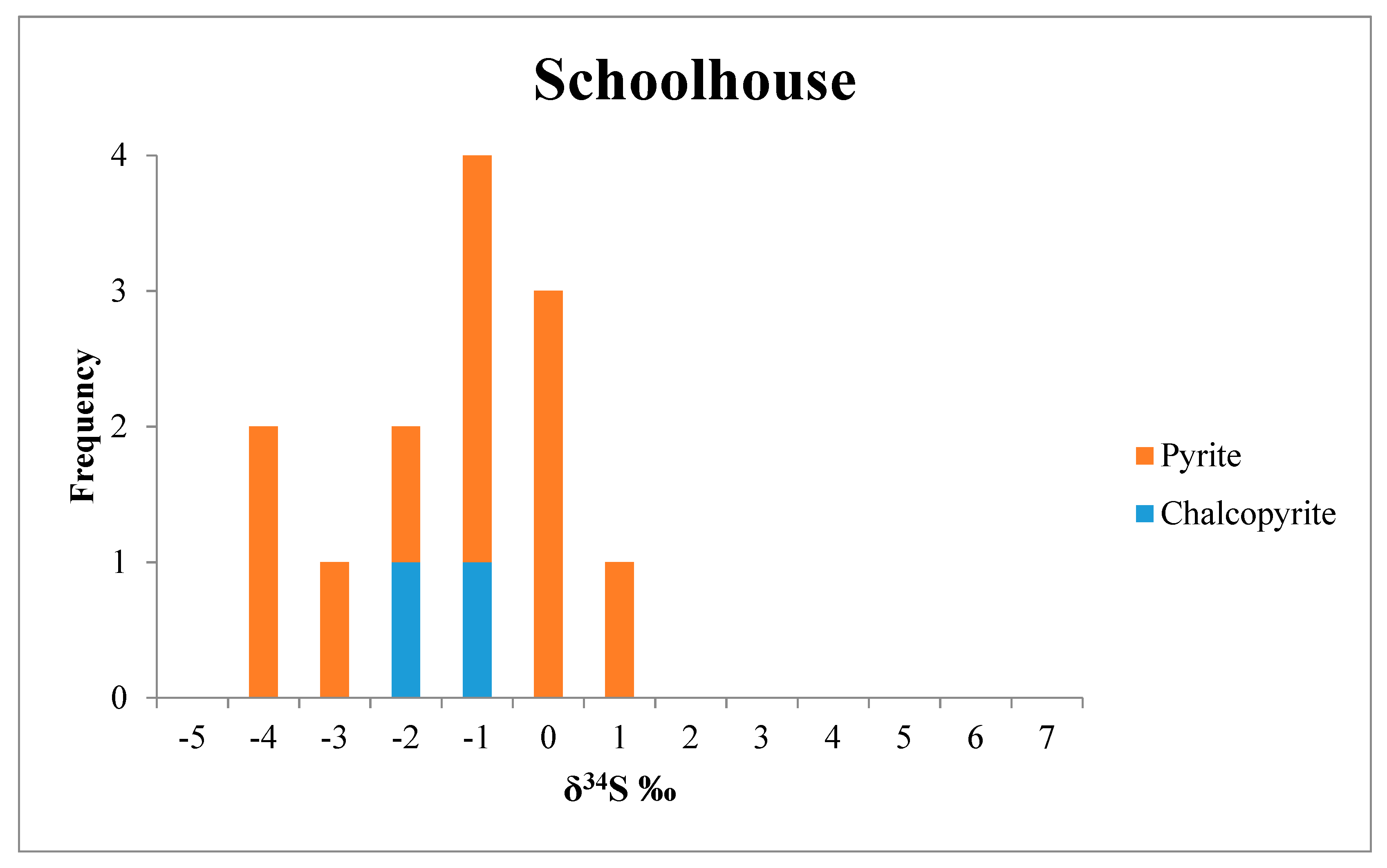
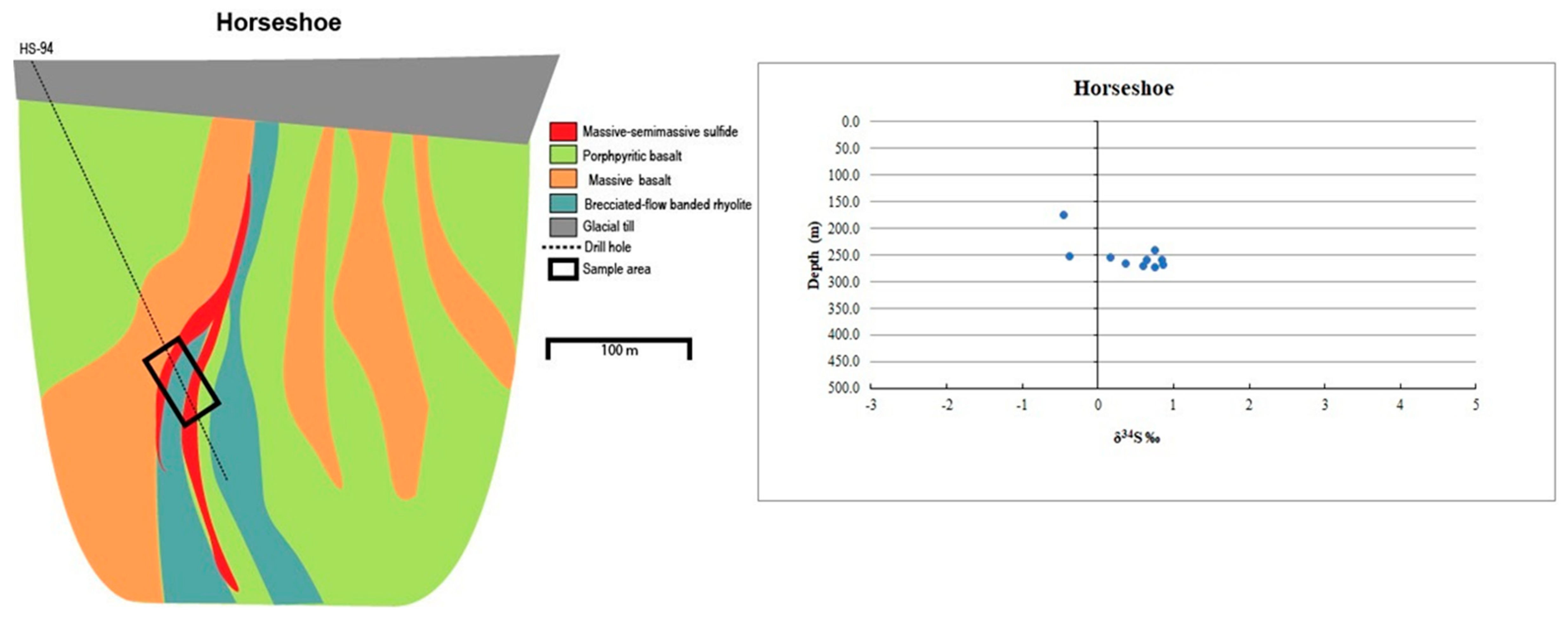




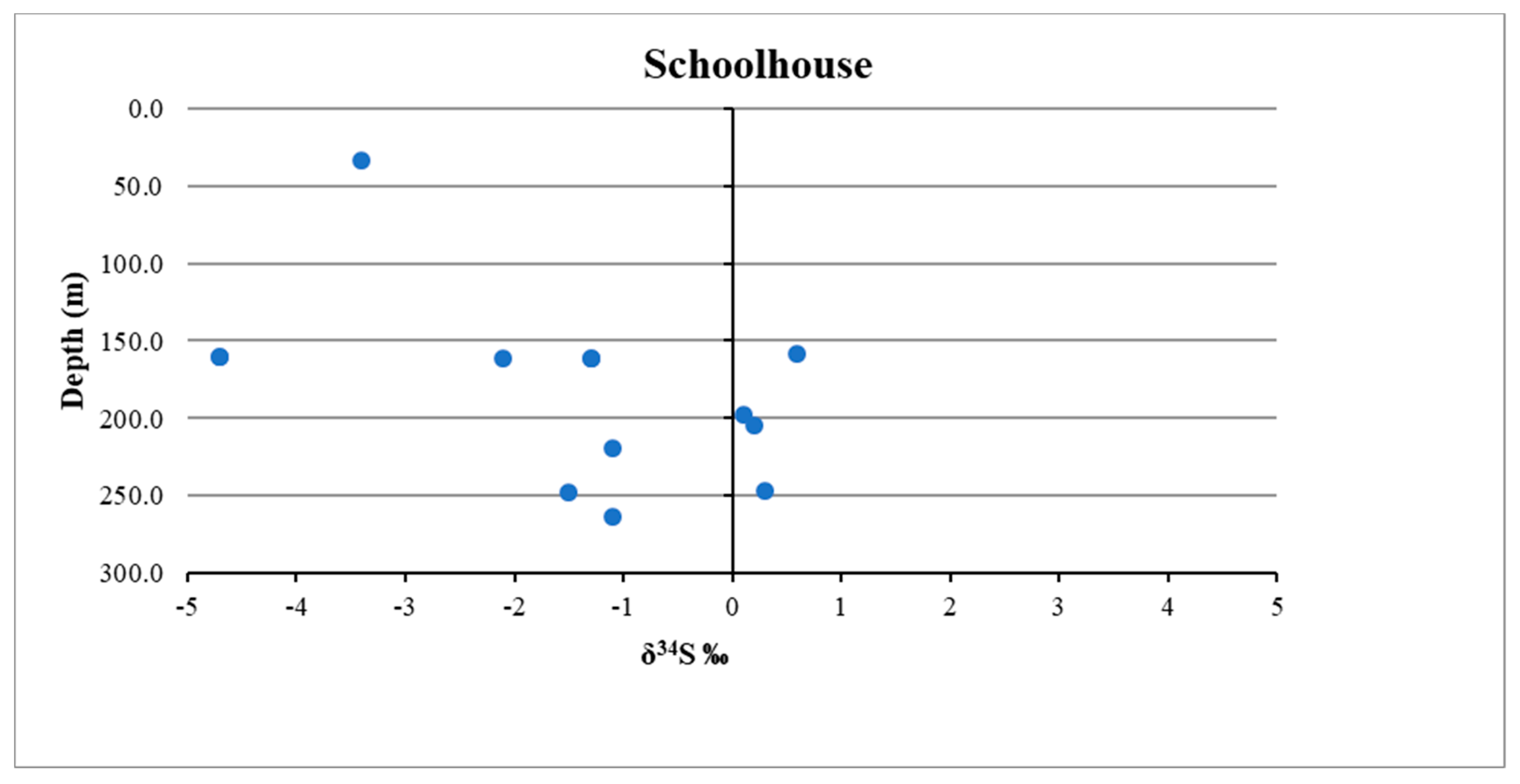
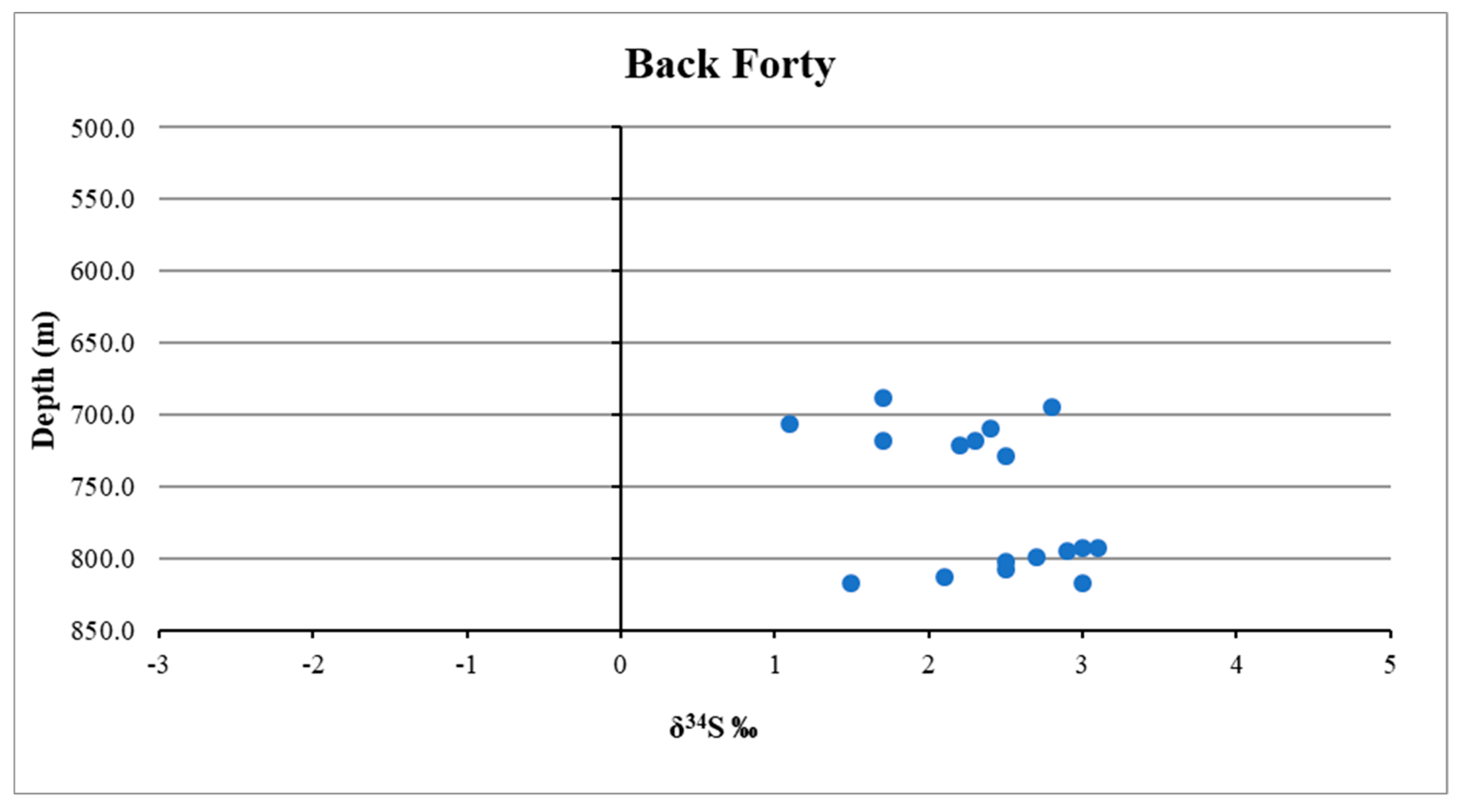
References
- Franklin, J.M.; Lydon, J.W.; Sangster, D.M. Volcanic-associated massive sulfide deposits. Econ. Geol. 1981, 75, 485–627. [Google Scholar]
- Large, R.R. Australian volcanic-hosted massive sulfide deposits; Features, styles, and genetic models. Econ. Geol. 1992, 87, 471–510. [Google Scholar] [CrossRef]
- Franklin, J.M.; Gibson, H.L.; Jonasson, I.R.; Galley, A.G. Volcanogenic massive sulfide deposits. Econ. Geol. 2005, 100, 523–560. [Google Scholar]
- Galley, A.G.; Hannington, M.D.; Jonasson, I.R. Volcanogenic massive sulphide deposits. Geol. Assoc. Can. Miner. Depos. Div. Spec. Publ. 2007, 5, 141–161. [Google Scholar]
- Barrie, C.T.; Hannington, M.D. Classification of volcanic-associated massive sulfide deposit based on host-rock composition. Rev. Econ. Geol. 1999, 8, 1–11. [Google Scholar]
- Large, R.R.; McPhie, J.; Gemmell, J.B.; Herrmann, W.; Davidson, G.J. The Spectrum of Ore Deposit Types, Volcanic Environments, Alteration Halos, and Related Exploration Vectors in Submarine Volcanic Successions: Some Examples from Australia. Econ. Geol. 2001, 96, 913–938. [Google Scholar] [CrossRef]
- Hannington, M.; Ronde, C.; Peterson, S. Sea-floor tectonics and submarine hydrothermal systems. Econ. Geol. 2005, 100, 111–141. [Google Scholar]
- Shanks, W.C. Stable isotopes in seafloor hydrothermal systems: Vent fluids, hydrothermal deposits, hydrothermal alteration, and microbial processes. Rev. Mineral. Geochem. 2001, 43, 469–517. [Google Scholar] [CrossRef]
- Huston, D.L. Stable isotopes and their significance for understanding the genesis of volcanic-hosted massive sulfide deposits: A review. Rev. Econ. Geol. 1999, 8, 157–176. [Google Scholar]
- Huston, D.L.; Pehrsson, S.; Eglington, B.M.; Zaw, K. The geology and metallogeny of volcanic-hosted massive sulfide deposits: Variations through geologic time and with tectonic setting. Econ. Geol. 2010, 105, 571–591. [Google Scholar] [CrossRef]
- Seal, R.R. Sulfur Isotope Geochemistry of Sulfide Minerals. Rev. Mineral. Geochem. 2006, 61, 633–677. [Google Scholar] [CrossRef]
- Ohmoto, H.; Rye, R.O. Isotopes of sulfur and carbon. In Geochemistry of Hydrothermal Ore Deposits, 2nd ed.; Barnes, H.L., Ed.; John Wiley and Sons: New York, NY, USA, 1979; pp. 509–567. [Google Scholar]
- Ohmoto, H. Formation of volcanogenic massive sulfide deposits: The Kuroko perspective. Ore Geol. Rev. 1996, 10, 135–177. [Google Scholar] [CrossRef]
- Jamieson, J.W.; Wing, B.A.; Hannington, M.D.; Farquhar, J. Evaluating isotopic equilibrium among sulfide mineral pairs in Archean ore deposits: A case study from the Kidd Creek VMS deposit, Ontario, Canada. Econ. Geol. 2006, 101, 1055–1061. [Google Scholar] [CrossRef]
- Sharpe, R.; Gemmell, J.B. Sulfur isotope characteristics of the Archean Cu-Zn Gossan Hill VHMS deposit, Western Australia. Miner. Depos. 2000, 35, 553–550. [Google Scholar] [CrossRef]
- Wagner, T.; Boyce, A.J.; Jonsson, E.; Fallick, A.E. Laser microprobe sulphur isotope analysis of arsenopyrite: Experimental calibration and application to the Boliden Au–Cu–As massive sulphide deposit. Ore Geol. Rev. 2004, 25, 311–325. [Google Scholar] [CrossRef]
- Bailie, R.; Gutzmer, J.; Strauss, H.; Stüeken, E.; McClung, C. Sulfur isotope characteristics of metamorphosed Zn–Cu volcanogenic massive sulfides in the Areachap Group, Northern Cape Province, South Africa. Miner. Depos. 2010, 45, 481–496. [Google Scholar] [CrossRef]
- Chen, M.; Campbell, I.; Xue, Y.; Tian, W.; Ireland, T.R.; Holden, P.; Cas, R.; Hayman, P.C.; Das, R. Multiple Sulfur Isotope Analyses Support a Magmatic Model for the Volcanogenic Massive Sulfide Deposits of the Teutonic Bore Volcanic Complex, Yilgarn Craton, Western Australia. Econ. Geol. 2015, 110, 1411–1423. [Google Scholar] [CrossRef]
- Vearncombe, S.E. Volcanogenic Massive Sulphide-Sulphate Mineralisation at Strelley, Pilbara Craton, Western Australia. Ph.D. Thesis, University of Western Australia, Perth, Australia, 1995. [Google Scholar]
- Ametrano, S.; Etcheverry, R.; Echeveste, H.; Godeas, M.; Zubia, M. VMS district of Tierra del Fuego, Argentina. Geol. Assoc. Can. Mineral Depos. Div. Spec. Publ. 2000, 2, 593–612. [Google Scholar]
- Lambert, I.B. Sulphur-isotope investigations of Archaean mineralization and some implications concerning geobiochemical evolution. In Archean Cherty Metasediments: Their Sedimentology, Micropaleontology, Biogeochemistry and Significance to Mineralization; Glover, J.E., Groves, D.I., Eds.; University of Western Australia: Perth, Australia, 1978; pp. 45–56. [Google Scholar]
- Bowins, R.J.; Crocket, J.H. Sulfur and carbon isotopes in Archean banded iron formations: Implications for sulfur sources. Chem. Geol. 1994, 111, 307–323. [Google Scholar] [CrossRef]
- Myers, L.L. Geochemistry of the Crandon Massive Sulfide Deposit, Wisconsin: Sulfur Isotope and Fluid Inclusion Data. Bachelor’s Thesis, University of Wisconsin-Madison, Madison, WI, USA, 1983. [Google Scholar]
- Schulz, K.J.; Cannon, W.F. The Penokean Orogeny in the Lake Superior Region. Precambrian Res. 2007, 157, 4–25. [Google Scholar] [CrossRef]
- DeMatties, T.A. Early Proterozoic volcanogenic massive sulfide deposits in Wisconsin: An overview. Econ. Geol. 1994, 89, 1122–1151. [Google Scholar] [CrossRef]
- LaBerge, G.L. General characteristics and geologic setting of the Wisconsin magmatic terranes. In olcanogenic Massive Sulfide Deposits of Northern Wisconsin: A Commemorative Volume; Institute on Lake Superior Geology: St Paul, MN, USA, 1996; pp. 17–30. [Google Scholar]
- Schulz, K.J.; Nicholson, S.W.; Van Schmus, W.R. Penokean massive sulfide deposits: Age, geochemistry, and paleotectonic setting. In Proceedings of the 54th Annual Meeting of the Institute on Lake Superior Geology, Marquette, MI, USA, 6–10 May 2008. [Google Scholar]
- Quigley, P.O. The Spectrum of Ore Deposit Types, Their Alteration and Volcanic Setting in the Penokean Volcanic Belt, Great Lakes Region, USA. MS Thesis, Colorado School of Mines, Golden, CO, USA, 2016. [Google Scholar]
- Boxleiter, A.; Thakurta, J.; Quigley, T. Geochemical investigation of the origin of the Back Forty volcanogenic massive sulfide deposit in Menominee County, MI. In Proceedings of the 60th Annual Institute on Lake Superior Geology Conference, Hibbing, MN, USA, 14–17 May 2014; pp. 17–18. [Google Scholar]
- DeMatties, T.A. A proposed geologic framework for massive sulfide deposits in the Wisconsin Penokean volcanic belt. Econ. Geol. 1989, 84, 946–952. [Google Scholar] [CrossRef]
- Sims, P.K. Geologic map of Precambrian rocks, Southern Lake Superior Region, Wisconsin and Northern Michigan. In U.S. Geological Survey Miscellaneous Investigation Series Map I-2185; USGS Publication: Reston, VA, USA, 1992. [Google Scholar]
- Sims, P.K.; Carter, L.M.H. Archean and Proterozoic Geology of the Lake Superior Region, U.S.A., 1993; USGS Publication: Reston, VA, USA, 1996.
- DeMatties, T.A.; Rowell, W.F. The Bend deposit. In Volcanogenic Massive Sulfide Deposits of Northern Wisconsin: A Commemorative Volume; Institute on Lake Superior Geology: St Paul, MN, USA, 1996; pp. 143–159. [Google Scholar]
- Quigley, A.K. Setting of Volcanogenic Massive Sulfide Deposits in the Penokean Volcanic Belt, Great Lakes Region, USA. MS Thesis, Colorado School of Mines, Golden, CO, USA, 2016. [Google Scholar]
- DeMatties, T.A. On Paleoproterozoic volcanogenic massive sulfide (VMS) mineralization in the Penokean volcanic belt, northen Wisconsin and eastern Michigan, USA: Implications for future exploration. Ore Geol. Rev. 2018, 95, 216–237. [Google Scholar] [CrossRef]
- Woodruff, L.; (United States Geological Survey, Reston, VA, USA). Personal communication. 2014.
- Piercy, S.J. The setting, style, and role of magmatism in the formation of volcanogenic massive sulfide deposits. Miner. Depos. 2011, 46, 449–471. [Google Scholar] [CrossRef]
- Thakurta, J.; Quigley, T. Geochemical characterization of the Back Forty volcanogenic massive sulfide deposit in Menominee County, Michigan. Geol. Soc. Am. Abstr. Programs 2013, 45, 806. [Google Scholar]
- Zens, Z.; Helmuth, S.; Lodge, R.W. Geochemistry and petrography of the strata hosting the Flambeau Cu-Zn-Au deposit; Revisiting Wisconsin’s only past-producing volcanogenic massive sulfide mine. Geol. Soc. Am. Abstr. Programs 2015, 47, 28. [Google Scholar]
- Thode, H.G.; Monster, J.; Dunford, H.B. Sulphur isotope geochemistry. Geochim. Cosmochim. Acta 1961, 25, 159–174. [Google Scholar] [CrossRef]
- Ripley, E.M.; Li, C. Sulfur isotope exchange and metal enrichment in the formation of magmatic Cu-Ni-(PGE) deposits. Econ. Geol. 2003, 98, 365–641. [Google Scholar] [CrossRef]
- Sakai, H.; DesMarais, D.J.; Ueda, A.; Moore, J.G. Concentrations and isotope ratios of carbon, nitrogen, and sulfur in ocean-floor basalts. Geochim. Cosmochim. Acta 1984, 48, 2430–2441. [Google Scholar] [CrossRef]
- Rees, C.E.; Jenkins, W.J.; Monster, J. The sulfur isotopic composition of ocean water sulfate. Geochim. Cosmochim. Acta 1978, 42, 377–381. [Google Scholar] [CrossRef]
- Claypool, G.E.; Holser, W.T.; Kaplan, I.R.; Sakai, H.; Zak, I. The age curves of sulfur and oxygen isotopes in marine sulfate and their mutual interpretation. Chem. Geol. 1980, 28, 199–260. [Google Scholar] [CrossRef]
- Chambers, L.A.; Trudinger, P.A. Microbiological fractionation of stable sulfur isotopes: A review and critique. Geomicrobiol. J. 1979, 1, 249–293. [Google Scholar] [CrossRef]
- Seal, R.R.; Wandless, G.A. Sulfur isotope evidence for sea-floor mineralizing processes at the Bald Mountain and Mount Chase massive sulfide deposits, northern Maine. Econ. Geol. Monogr. 2003, 11, 567–587. [Google Scholar]
- Sims, P.K.; Van Schmus, W.R.; Schulz, K.J.; Peterman, Z.E. Tectono-stratigraphic evolution of the Early Proterozoic Wisconsin magmatic terranes of the Penokean orogen. Can. J. Earth Sci. 1989, 25, 2145–2158. [Google Scholar] [CrossRef]
- Canfield, D.E.; Teske, A. Late Proterozoic rise in atmospheric oxygen concentration inferred from phylogenetic and sulphur-isotope studies. Nature 1996, 382, 127–132. [Google Scholar] [CrossRef] [PubMed]
- Gellatly, A.M.; Lyons, T.W. Trace sulfate in mid-Proterozoic carbonates and the sulfur isotope record of biospheric evolution. Geochim. Cosmochim. Acta 2005, 69, 3813–3829. [Google Scholar] [CrossRef]
- Slack, J.F.; Grenne, T.; Bekker, A.; Rouxel, O.J.; Lindberg, P.A. Suboxic deep seawater in the late Paleoproterozoic: Evidence from hematitic chert and iron formation related to seafloor-hydrothermal sulfide deposits, central Arizona, USA. Earth Planet. Sci. Lett. 2007, 255, 243–256. [Google Scholar] [CrossRef]

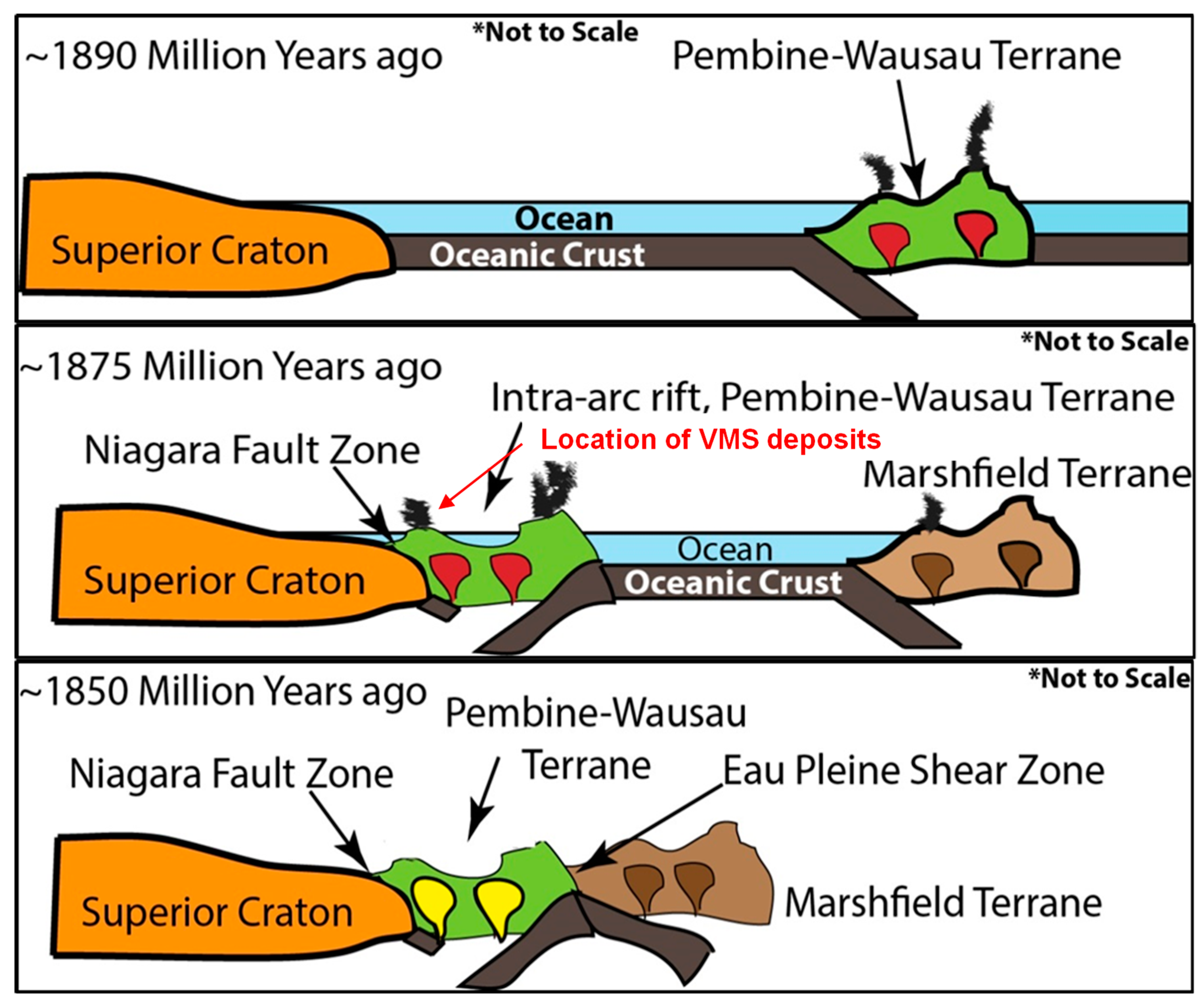
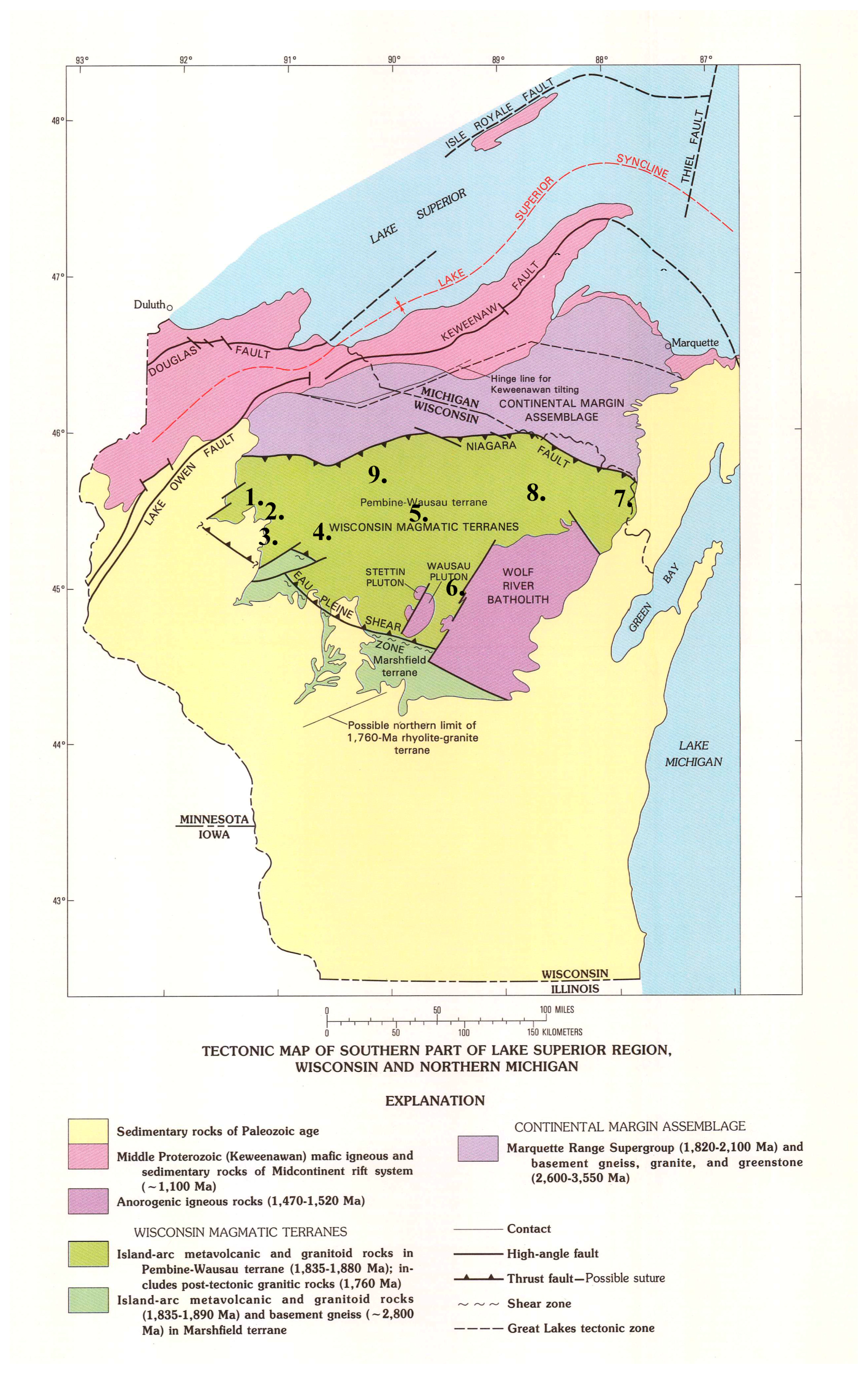

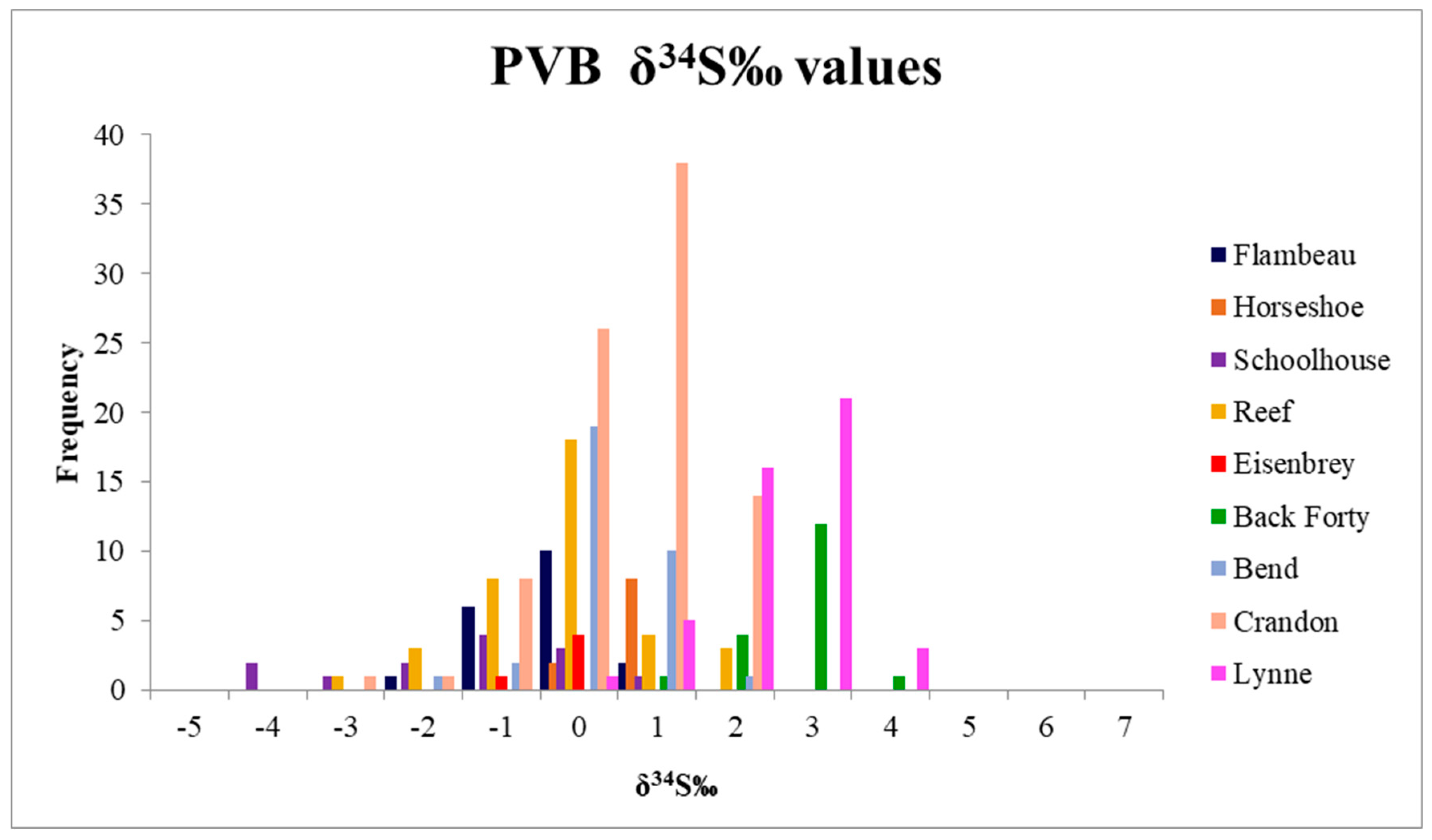
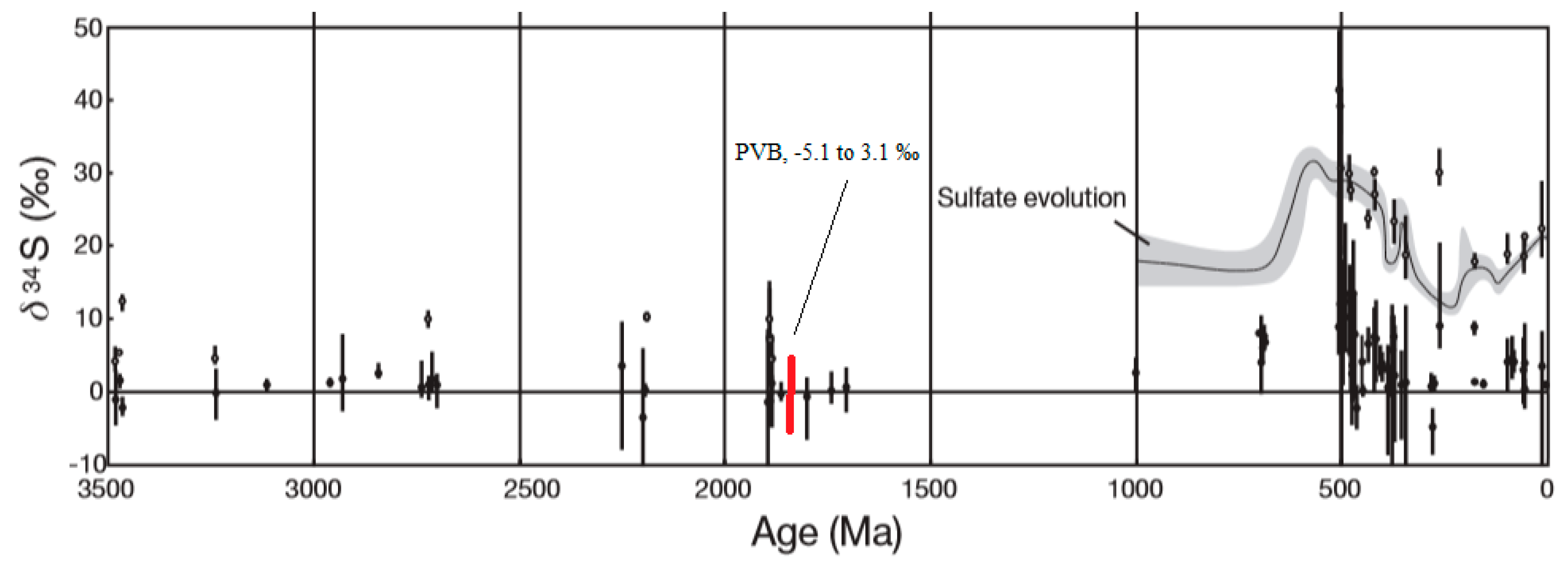
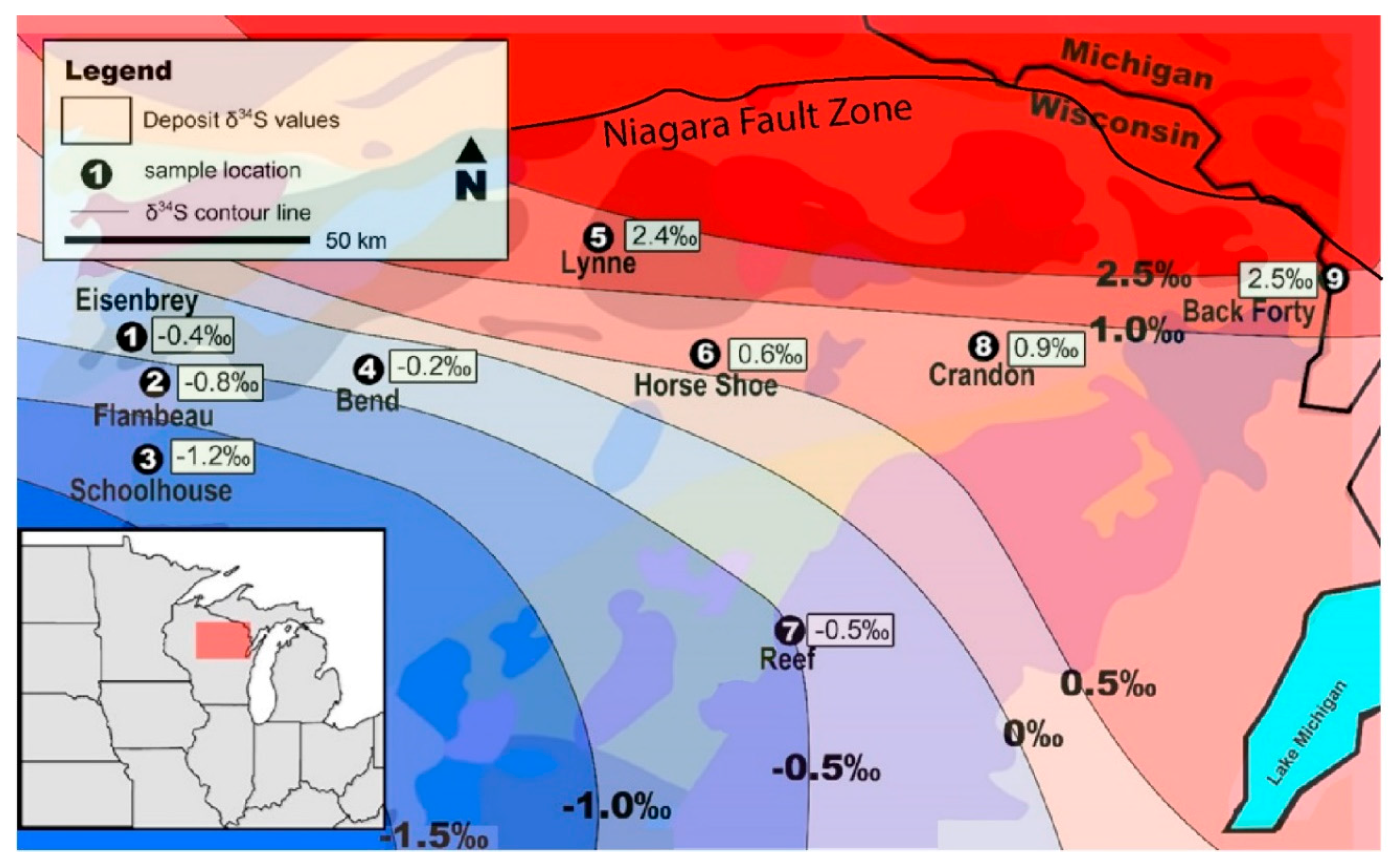
| Deposit | Sample ID | Depth (m) | Sulfide Mineral | δ34S ‰ |
|---|---|---|---|---|
| Flambeau | ||||
| FL-22-71-5 | 155.45 | pyrite | −1.2 | |
| FL-22-87-6 | 163.68 | sphalerite | −0.7 | |
| FL-22-71-4 | 168.86 | pyrite | −0.1 | |
| FL-22-71-7 | 169.47 | pyrite | −0.3 | |
| FL-22-87-4 | 170.38 | pyrite | −0.1 | |
| FL-22-71-2 | 170.69 | chalcopyrite | −0.8 | |
| FL-22-87-1 | 181.97 | pyrite | −0.7 | |
| FL-22-89-10 | 185.01 | pyrite | −1.2 | |
| FL-22-89-9 | 186.84 | pyrite | −1.3 | |
| FL-22-89-8 | 191.72 | pyrite | −1.1 | |
| FL-22-89-7 | 192.63 | chalcopyrite | 0.3 | |
| FL-22-89-6 | 199.03 | pyrite | −1.1 | |
| FL-22-89-4 | 201.78 | pyrite | 0.4 | |
| FL-22-89-5 | 204.22 | chalcopyrite | −2.1 | |
| FL-22-89-3 | 206.35 | pyrite | −0.8 | |
| FL-22-89-1 | 207.57 | pyrite | −1.2 | |
| Horseshoe | ||||
| HS-94-1 | 173.74 | chalcopyrite | −0.5 | |
| HS-94-7 | 241.10 | pyrite | 0.8 | |
| HS-94-8 | 251.16 | pyrite | −0.4 | |
| HS-94-9 | 254.20 | pyrite | 0.2 | |
| HS-94-11 | 258.17 | pyrite | 0.7 | |
| HS-94-10 | 258.47 | chalcopyrite | 0.9 | |
| HS-94-12 | 264.87 | chalcopyrite | 0.4 | |
| HS-94-13 | 267.00 | sphalerite | 0.9 | |
| HS-94-14 | 270.05 | pyrite | 0.6 | |
| HS-94-15 | 272.19 | pyrite | 0.8 | |
| Schoolhouse | ||||
| SH-1-5 | 33.22 | pyrite | −3.4 | |
| SH-1-4 | 158.50 | pyrite | 0.6 | |
| SH-1-1 | 160.93 | pyrite | −1.3 | |
| SH-1-3 | 161.24 | pyrite | −2.1 | |
| SH-3-3 | 198.12 | pyrite | 0.1 | |
| SH-3-2 | 204.22 | pyrite | 0.2 | |
| SH-3-1 | 219.15 | pyrite | −1.1 | |
| SH-8-1 | 247.19 | pyrite | 0.3 | |
| SH-11-1 | 248.11 | chalcopyrite | −1.5 | |
| SH-8-2 | 263.35 | chalcopyrite | −1.1 | |
| Eisenbrey | ||||
| EI-T-8-3 | 122.22 | pyrite | −0.4 | |
| EI-T-8-5 | 122.22 | pyrite | −0.3 | |
| EI-T-8-2 | 133.20 | pyrite | −0.3 | |
| EI-T-8-4 | 133.20 | pyrite | −0.6 | |
| EI-T-8-1 | 142.95 | chalcopyrite | −0.6 | |
| Reef | ||||
| RE-11-11-12 | 16.46 | pyrite | −1.4 | |
| RE-11-11-11 | 19.51 | pyrite | −0.4 | |
| RE-11-11-10 | 24.69 | pyrite | −0.3 | |
| RE-11-11-14 | 26.52 | pyrite | −0.7 | |
| RE-11-11-7 | 28.96 | pyrite | −0.5 | |
| RE-11-11-8 | 30.48 | pyrite | −0.6 | |
| RE-11-11-9 | 33.22 | pyrite | 0.2 | |
| RE-11-11-5 | 39.62 | pyrite | −0.3 | |
| RE-11-11-4 | 41.61 | pyrite | −0.9 | |
| RE-11-11-3 | 49.07 | chalcopyrite | −0.3 | |
| RE-11-11-2 | 50.90 | chalcopyrite | 1.0 | |
| RE-11-11-18 | 51.21 | pyrite | 1.2 | |
| RE-11-11-1 | 53.04 | pyrite | −1.3 | |
| RE-11-11-13 | 55.47 | pyrite | −0.8 | |
| RE-11-11-6 | 70.10 | pyrite | 1.2 | |
| RE-91-49-6 | 98.15 | pyrite | −0.2 | |
| RE-91-49-5 | 100.89 | pyrite | −0.4 | |
| RE-91-49-8 | 103.63 | pyrite | −1.7 | |
| RE-91-49-7 | 105.16 | pyrite | −1.8 | |
| RE-91-49-12 | 110.95 | pyrite | −2.2 | |
| RE-91-49-19 | 112.47 | pyrite | −1.0 | |
| RE-91-49-9 | 114.91 | pyrite | −1.5 | |
| RE-91-49-10 | 118.57 | pyrite | −0.5 | |
| RE-91-49-15 | 120.40 | pyrite | −0.4 | |
| RE-91-49-14 | 123.75 | pyrite | −0.5 | |
| RE-91-49-13 | 124.05 | pyrite | 0.1 | |
| RE-91-49-11 | 129.84 | pyrite | −2.4 | |
| RE-89-46-3 | 141.43 | pyrite | −1.3 | |
| RE-89-46-2 | 148.44 | pyrite | 0.3 | |
| RE-89-46-1 | 157.28 | pyrite | 1.3 | |
| RE-91-49-18 | 164.59 | pyrite | −0.1 | |
| RE-91-49-17 | 165.51 | pyrite | −0.6 | |
| RE-91-49-3 | 204.52 | pyrite | −0.6 | |
| RE-91-49-2 | 205.13 | pyrite | −1.2 | |
| RE-91-49-1 | 220.68 | pyrite | −3.0 | |
| RE-91-49-4 | 222.81 | pyrite | −1.5 | |
| RE-91-49-16 | 227.99 | pyrite | −0.3 | |
| Bend | ||||
| BE-12-01-4 | 106.70 | pyrite | −0.2 | |
| BE-12-01-6 | 112.30 | pyrite | 0.2 | |
| BE-12-01-7 | 119.00 | pyrite | −0.4 | |
| BE-1-17 | 127.41 | chalcopyrite | −1.0 | |
| BE-1-16 | 131.98 | pyrite | −0.6 | |
| BE-12-01-8 | 133.50 | pyrite | 0.2 | |
| BE-1-15 | 136.25 | pyrite | 0.7 | |
| BE-1-14 | 136.86 | chalcopyrite | −0.6 | |
| BE-1-13 | 141.73 | pyrite | −0.3 | |
| BE-1-11 | 142.04 | pyrite | −0.2 | |
| BE-1-12 | 142.65 | pyrite | −0.2 | |
| BE-1-10 | 148.44 | pyrite | −0.7 | |
| BE-1-9 | 150.88 | pyrite | 0.4 | |
| BE-1-8 | 166.42 | pyrite | −0.4 | |
| BE-1-4 | 168.55 | pyrite | 0.0 | |
| BE-1-6 | 168.55 | pyrite | 0.3 | |
| BE-1-5 | 168.86 | pyrite | 0.0 | |
| BE-1-7 | 169.16 | pyrite | −0.4 | |
| BE-1-3 | 193.24 | pyrite | 1.0 | |
| BE-1-2 | 207.87 | chalcopyrite | −2.3 | |
| BE-12-01-12 | 210.00 | pyrite | −0.9 | |
| BE-1-1 | 216.41 | chalcopyrite | −0.6 | |
| BE-12-01-11 | 219.50 | pyrite | 0.4 | |
| BE-12-3 | 242.62 | pyrite | −0.8 | |
| BE-12-1 | 272.49 | pyrite | 0.1 | |
| BE-12-2 | 272.80 | pyrite | 0.5 | |
| BE-12-08-1 | 488.50 | pyrite | 1.2 | |
| BE-12-08-2 | 498.50 | pyrite | 0.0 | |
| BE-12-08-3 | 507.20 | pyrite | −0.5 | |
| BE-12-08-4 | 519.00 | pyrite | −0.2 | |
| BE-12-08-6 | 543.00 | pyrite | −1.2 | |
| BE-12-08-7 | 548.20 | pyrite | −0.1 | |
| BE-12-08-8 | 567.00 | pyrite | −0.6 | |
| Back Forty | ||||
| BF-484-1 | 688.4 | pyrite | 1.7 | |
| BF-484-2 | 694.6 | chalcopyrite | 2.8 | |
| BF-484-4 | 706.8 | galena | 1.1 | |
| BF-484-5 | 709.9 | pyrite | 2.4 | |
| BF-484-6 | 718.3 | pyrite | 2.3 | |
| BF-484-6 | 718.3 | chalcopyrite | 1.7 | |
| BF-484-7 | 721.0 | sphalerite | 2.2 | |
| BF-484-8 | 729.0 | pyrite | 2.5 | |
| BF-479-1 | 792.5 | pyrite | 3.1 | |
| BF-479-2 | 793.1 | pyrite | 3 | |
| BF-479-3 | 795.1 | pyrite | 2.9 | |
| BF-479-4 | 799.3 | pyrite | 2.7 | |
| BF-479-5 | 802.5 | sphalerite | 2.5 | |
| BF-479-6 | 808.1 | pyrite | 2.5 | |
| BF-479-7 | 813.5 | sphalerite | 2.1 | |
| BF-479-8 | 817.0 | pyrite | 3 | |
| BF-479-9 | 817.2 | chalcopyrite | 1.5 | |
| Lynne | ||||
| LN 90-12 | 26.06 | sphalerite | 2.3 | |
| LN 90-12 | 26.52 | pyrrhotite | 3.4 | |
| LN 90-12 | 27.43 | sphalerite | 2.2 | |
| LN 90-28 | 52.27 | pyrrhotite | 4.5 | |
| LN 90-12 | 53.34 | sphalerite | 1.5 | |
| LN 90-7 | 76.20 | sphalerite | 2.2 | |
| LN 90-16 | 97.84 | sphalerite | 3.1 | |
| LN 90-16 | 104.24 | pyrrhotite | 1.4 | |
| LN 90-18 | 108.20 | sphalerite | 2.7 | |
| LN 90-18 | 111.56 | sphalerite | 2.0 | |
| LN 90-16 | 111.86 | pyrrhotite | 1.5 | |
| LN 90-7 | 114.00 | sphalerite | 2.3 | |
| LN 90-16 | 114.30 | pyrrhotite | 2.8 | |
| LN 90-7 | 118.26 | sphalerite | 3.4 | |
| LN 90-7 | 121.62 | sphalerite | 1.7 | |
| LN 90-16 | 131.37 | sphalerite | 1.5 | |
| LN 90-7 | 136.25 | sphalerite | 2.4 | |
| LN 90-16 | 138.99 | sphalerite | 3.4 | |
| LN 90-16 | 144.02 | sphalerite | 2.2 | |
| LN 90-18 | 161.24 | sphalerite | 2.0 | |
| LN 90-40 | 164.59 | pyrrhotite | 3.3 | |
| LN 90-40 | 175.26 | sphalerite | 3.8 | |
| LN 90-40 | 175.26 | pyrrhotite | 3.6 | |
| LN 90-18 | 175.87 | galena | 0.7 | |
| LN 90-40 | 186.84 | pyrrhotite | 3.4 | |
| LN 90-40 | 220.98 | galena | 1.1 |
| Deposit | Number of Samples | δ34S Range (‰) | Median |
|---|---|---|---|
| Flambeau | 16 | −2.1 to 0.4 | −0.8 |
| Horseshoe | 10 | −0.5 to 0.9 | 0.7 |
| Schoolhouse | 10 | −3.4 to 0.6 | −1.1 |
| Eisenbrey | 5 | −0.6 to −0.3 | −0.4 |
| Reef | 37 | −3.0 to 1.3 | −0.5 |
| Bend | 33 | −2.3 to 1.2 | −0.2 |
| Back Forty | 17 | 1.1 to 3.1 | 2.5 |
| Lynne | 26 | 0.7 to 4.5 | 2.4 |
© 2018 by the authors. Licensee MDPI, Basel, Switzerland. This article is an open access article distributed under the terms and conditions of the Creative Commons Attribution (CC BY) license (http://creativecommons.org/licenses/by/4.0/).
Share and Cite
Moleski, N.; Boxleiter, A.; Thakurta, J. Sulfur Isotope Ratios from VMS Deposits in the Penokean Volcanic Belt, Great Lakes Region, USA: Constraints on the Source of Sulfur in a Paleoproterozoic Intra-Arc Rift. Minerals 2019, 9, 6. https://doi.org/10.3390/min9010006
Moleski N, Boxleiter A, Thakurta J. Sulfur Isotope Ratios from VMS Deposits in the Penokean Volcanic Belt, Great Lakes Region, USA: Constraints on the Source of Sulfur in a Paleoproterozoic Intra-Arc Rift. Minerals. 2019; 9(1):6. https://doi.org/10.3390/min9010006
Chicago/Turabian StyleMoleski, Nicholas, Anthony Boxleiter, and Joyashish Thakurta. 2019. "Sulfur Isotope Ratios from VMS Deposits in the Penokean Volcanic Belt, Great Lakes Region, USA: Constraints on the Source of Sulfur in a Paleoproterozoic Intra-Arc Rift" Minerals 9, no. 1: 6. https://doi.org/10.3390/min9010006
APA StyleMoleski, N., Boxleiter, A., & Thakurta, J. (2019). Sulfur Isotope Ratios from VMS Deposits in the Penokean Volcanic Belt, Great Lakes Region, USA: Constraints on the Source of Sulfur in a Paleoproterozoic Intra-Arc Rift. Minerals, 9(1), 6. https://doi.org/10.3390/min9010006





